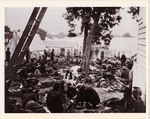"When General McClellan's Army was transferred to the Peninsula [Virginia], the 16th Regiment followed, and arrived at Ship Point at the mouth of the York River, on April 30. On May 7, it reached West Point and participated in that engagement, losing 20 men, either killed or wounded."
"The following is an excerpt from "The Story of the 16th New York Infantry From Bull Run to Chancellorsville", written by General Newton Martin Curtis of Ogdensburg. General Curtis was Captain of Company G, 116th Regiment at that time, and was wounded in that battle."
BATTLE OF WEST POINT, VIRGINIA
"After landing at the head of York River, the Regiment marched a short distance and stacked arms. After supper was over, the members of Company F were engaged in general conversation, when Edwin R. Bishop, a light-hearted and fun-provoking man rose from the ground and interrupted the conversation by saying: 'Boys, if I should fall in the next battle, as I now believe I shall, I wish you would bury me under this tree where I indicate the these lines.' He then proceeded to mark with a pioneer's spade the outlines of a grave."
"Immediately, Corporal George J. Lave, a very sedate man, rose and picking up the spade which Bishop had used, said: 'I would like you to dig my grave beside Bishop's, but please dig it with more regularity than this crooked lines indicate. I am the son of a sexton and have helped to dig many'. He then proceeded to draw a parallelogram, dropped the spade and sat down."
"Then, Peter G. Ploof, a lad of twenty, much beloved for his boyish, winsome ways, picked up the spade, and said: 'If I fall, dig my grave here beside Lave's, do it as we dig graves at home. Please follow the lines I make for you'. He drew the lines of the coffin used in those days, wider at the shoulders and tapering toward the head and foot. Conversation was resumed and no further attention paid to the incident".
"At three o'clock the next morning, May 7, 1862, Company F under Capt. John C. Gilmore, from Potsdam, and Company G from DePeyster were ordered out to the picket line, where at 9 a.m. they met the advancing lines of General J. B. Hood's brigade of Whitman's division. These Companies could not stay the progress of the overwhelming force brought against them, but they made a manful resistance until the artillery was brought up and made ready for action; they were then ordered back, with 17 percent of their number among the killed and wounded. Three members of Company F were killed - Bishop, Lave and Ploof - and their comrades, in paying them the martial honors due the gallant dead, gave to each the resting place he had selected on the night before the battle. Beside them were buried Hummery Seabury, and Waymouth of Company G."
"The 16th was in battles of Peninsular Campaign - Mechanicsville, Gaines' Mill and Charles City Crossroads. At Gaines Mill, the Regiment made a gallant charge and retook tow pieces of artillery which had been lost. They lost 230 men in this battle. Col. Marsh was mortally wounded. Capt. Gibson lost both eyes, and Col. Howland so severely hurt so as to cause his resignation the following September."
"After June 27, 1862, the 16th Regiment was known as the 'Straw Hat Men of History', who fought hardest, suffered most, and who could not be driven by the enemy, and never disobeyed an order except when commanded to retreat."
"In all, the Regiment was engaged in 18 skirmishes, reconnaissances and battles, lost 587 men, killed and wounded, and achieved worthy laurels for itself and lasting glory to the country. In May 1863, it returned home at the expiration of its term of service, 281 strong."

Replica Roger Dubuis Replica Rolex Datejust Replica Vacheron Constantin Replica Panerai Radiomir Tourbillon Replica IWC Aquatimer Automatic
16th Regiment,
New York Volunteers (in straw hats)
awaiting medical treatment following the Battle of Gaines' Mill,
Virginia, June 27, 1862
Photograph by Matthew Brady
Collection of the Minnesota Historical Society
New York Volunteers (in straw hats)
awaiting medical treatment following the Battle of Gaines' Mill,
Virginia, June 27, 1862
Photograph by Matthew Brady
Collection of the Minnesota Historical Society

